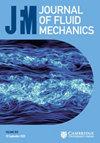Experimental investigation of three-dimensional Rayleigh–Taylor instability of a gaseous interface
IF 3.9
2区 工程技术
Q1 MECHANICS
引用次数: 0
Abstract
Validating the theoretical work on Rayleigh–Taylor instability (RTI) through experiments with an exceptionally clean and well-characterized initial condition has been a long-standing challenge. Experiments were conducted to study the three-dimensional RTI of an SF气态界面的三维瑞利-泰勒不稳定性实验研究
通过实验验证雷利-泰勒不稳定性(RTI)方面的理论研究工作,并使用异常干净和特征明确的初始条件,一直是一个长期存在的挑战。实验研究了中等阿特伍德数下 SF $_6$ - 空气界面的三维 RTI。研究人员开发了一种新颖的肥皂膜技术,以创建具有可控初始条件的不连续气态界面。频谱分析表明,皂膜界面的初始扰动是整个单模扰动的一半。确定了初始界面扰动与阿特伍德数之间的相关性。由于初始皂膜界面的陡峭和高度弯曲特征,RTI 的早期时间演化表现出明显的非线性。在准稳定体系中,各种势流模型通过将通道宽度视为扰动波长,准确预测了后期的气泡速度。不同的是,这些势流模型使用整个单模扰动的波长来描述晚期尖峰速度。这些研究结果表明,气泡的演变主要受到壁的空间限制的影响,而尖峰的演变主要受到尖峰顶端初始曲率的影响。因此,采用了最新的势流模型来描述 RTI 诱导的时变振幅增长。此外,实验还确定了气泡和尖峰的自相似生长因子,并与现有研究进行了比较,结果表明初始皂膜界面的大振幅会促进尖峰的发展。
本文章由计算机程序翻译,如有差异,请以英文原文为准。
求助全文
约1分钟内获得全文
求助全文
来源期刊
CiteScore
6.50
自引率
27.00%
发文量
945
审稿时长
5.1 months
期刊介绍:
Journal of Fluid Mechanics is the leading international journal in the field and is essential reading for all those concerned with developments in fluid mechanics. It publishes authoritative articles covering theoretical, computational and experimental investigations of all aspects of the mechanics of fluids. Each issue contains papers on both the fundamental aspects of fluid mechanics, and their applications to other fields such as aeronautics, astrophysics, biology, chemical and mechanical engineering, hydraulics, meteorology, oceanography, geology, acoustics and combustion.

 求助内容:
求助内容: 应助结果提醒方式:
应助结果提醒方式:


